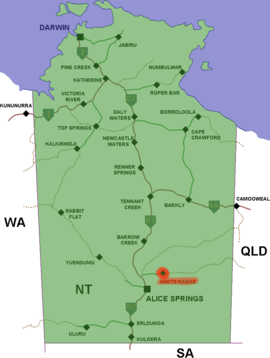Town in the Northern Territory, Australia
| Harts Range Northern Territory | |
|---|---|
 Location in the Northern Territory (red) Location in the Northern Territory (red) | |
 | |
| Coordinates | 22°59′12″S 134°55′15″E / 22.9867°S 134.9209°E / -22.9867; 134.9209 |
| Established | 16 May 1990 |
| Time zone | ACST (UTC+9:30) |
Harts Range, officially registered as Hart Range, is a town in the Northern Territory of Australia located on the Plenty Highway 215 km (134 mi) by road northeast of Alice Springs. It is also the name of a mountain range, after which it was named. It has also been referred to as Hart's Range. The Plenty River runs to the north of the range and the town.
History
The area is rich in minerals, and from the 1880s until 1960 the Harts Range area produced most of Australia's mica and one of these mines was the Spotted tiger mine. Many of the miners who arrived after the First World War (1918) were Italian, with no experience of mining. After 1945 Italian immigration to the area increased, many of them with families. Mining occurred mainly in the Central Harts Range District, where the new migrants established settlements. The Plenty Highway and other transport services were developed as a result of these migrants' activities, and they formed the basis of Central Australia's Italian community that still exists today.
The Governor of New South Wales, Lord Wakehurst, and his wife visited the area in March 1945.
The miners used local Aboriginal people for labour and for their knowledge. A 1950 newspaper article reports the value of mineral production from Hart's Range and the Plenty River as £79,321, but said that the profits had not flowed into the miners' wages, who had only received "no wage increase (other than the phoney cost of living adjustments made each quarter) since 1947".
In 2005 the area was shortlisted as a potential site for a low-level and intermediate-level radioactive waste storage and disposal facility, raising concerns that the local hydrogeology could result in spills contaminating the ground water.
Geology and geography
The basement rocks of the Harts Range group were formed in the lower to middle Proterozoic Eon, and have undergone complex metamorphic heating and deformation events. Later, in an orogenic event during the Cambrian Period, plutonic igneous activity generated magma of granitic composition, and in the final stages of crystallisation, pegmatites were intruded into the adjacent basement rocks. Although the granite pluton has not been exposed by erosion, the pegmatites which contain muscovite, or white mica, were mined for mica from the 1890s to 1960.
The former mica mines at Mount Palmer are now abandoned, and popular as a fossicking area.
Demographics
Most of the town's population are of Aboriginal descent, residing in the nearby community of Atitjere.
Recreation and events
Since 1947, each year an annual racing meet, the "Harts Range Races" has been held at the Harts Range Racecourse on the Picnic Day long weekend. The event has grown to include rodeo, novelty, and family events in a three-day festival.
Facilities
Harts Range Police Station services the surrounding district, comprising remote cattle stations and Aboriginal communities.
A transmitter for the Jindalee Operational Radar Network is located near Harts Range.
References
- ^ "Place Names Register Extract for the Town of Hart Range". NT Place Names Register. Northern Territory Government. Retrieved 18 March 2020.
Named after nearby Harts Range
Click on map and NT Atlas to see location and naming: Town is listed as Hart Range, but the school, police station, etc. are called "Harts Range". - "Hart's Range races revived". Kalgoorlie Miner. Vol. 59, no. 16578. Western Australia. 27 August 1953. p. 4. Retrieved 7 April 2023 – via National Library of Australia.
- "Spotted Tiger Mine, Mt Riddock Station, Harts Range (Harts Ranges; Hartz Range; Hartz Ranges), Central Desert Region, Northern Territory, Australia". www.mindat.org. Retrieved 20 January 2025.
- Hugo, David Frederick (1995). "Mica mining at Harts Range, Central Australia, 1880s-1960: a study of ethnicity and the impact of isolation". Student thesis: Doctor of Philosophy (PhD) - CDU: 274–278. doi:10.25913/5EB1F21464F55.
- ^ Hugo, D. F. (November 1995). Mica mining at Harts Range, Central Australia, 1880s-1960: a study of ethnicity and the impact of isolation (PhD (History)). Charles Darwin University. doi:10.25913/5eb1f21464f55.
- "Lord Wakehurst in Territory". Army News. Vol. 4, no. 1146. Northern Territory. 16 March 1945. p. 1. Retrieved 7 April 2023 – via National Library of Australia.
- "Miners don't get it". Northern Standard. Vol. 5, no. 192. Northern Territory, Australia. 3 February 1950. p. 3. Retrieved 7 April 2023 – via National Library of Australia.
- Salleh, Anna (3 August 2005). "Shifting rivers cast doubt on nuclear dump". ABC News (Australia). News in Science. Retrieved 7 April 2023.
- ^ "Central Harts Range". Fossicking in the Northern Territory. NT Government. 31 May 2016. Retrieved 7 April 2023.
- "Geology of Central Harts Range". Fossicking in the Northern Territory. NT Government. 31 May 2016. Retrieved 7 April 2023.
- "About Harts Range Amateur Racing Club". Harts Range Amateur Racing Club. Retrieved 7 April 2023.
- Darken, Bob (April 1993). "Club History". Harts Range Amateur Racing Club. Retrieved 7 April 2023.
- "Harts Range". NT Police, Fire & Emergency Services. Retrieved 7 April 2023.
- Chlanda, Erwin (28 April 2004). "Nowhere to hide when Alice's radar zeroes in". Alice Springs News. Retrieved 7 April 2023.